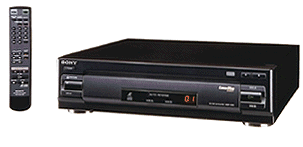 BUYING A LASERDISC PLAYER
BUYING A LASERDISC PLAYER
We point you in
the right direction
Laserdisc was to video
what the compact disc is to audio: a shiny silver disc that won't wear
out (theoretically) and that promises the best reproduction of the recorded
medium possible. It was "the Lexus of video" until DVD
came along.
Besides having to
duke it out with DVD, laserdisc has
one very big drawback, or at least it could be a drawback to some: it
can't record. That means it's useless if you want to tape TV programs,
copy tapes from camcorders etc. DVD
presently has the same flaw, but it has other advantages.
Laserdisc players
typically claim a horizontal resolution (which describes the detail it's
capable of reproducing) of 425 lines, as compared to about 250 for VHS.
But resolution only tells part of the story; everything about the picture,
including colour reproduction, blows VHS out of the water.
There are other advantages,
too. Laserdisc players also handle audio CD's, so if you haven't yet bought
a CD player, or want to relegate the one you have to another room in the
house, laserdisc rides to the rescue.
Discs, like CD's,
are also a lot more convenient. Most discs released in recent years are
equipped with "chapter stops" like the tracks on CD's, so if you have
a favourite scene you want to find, you can go there reasonably directly.
You can also search a disc by time, and of course once the movie's over
you can just eject the disc without having to sit there and wait for it
to rewind.
Disadvantages? Sure.
Besides not being able to record, the discs themselves are a lot bigger
than CD's, so they won't fit into your CD case. However, because the discs
are 12 inches in diameter, they're perfect at fitting the space left vacant
when you moved your LP's into the basement. So you can recycle some of
your furniture!
You also have to flip
the discs over to play a whole movie, and if the flick is longer than
two hours you'll have to change discs as well. That's because the CLV
disc speed only gives an hour per side. CAV discs only play for half that
long, but even the cheapest laserdisc player on the market will be able
to take advantage of CAV's remarkable special effects capabilities.
Another potential
drawback to laserdiscs is a lack of software. Oh, just about anything
you want to see is available on disc, and there are a lot of special editions
you can't get on videocassette, but finding them can be a pain. There
just aren't enough software rental stores that carry discs and the DVD
format will frighten a good many retailers out of from sinking a lot of
dollars into laserdisc inventory. Fortunately, laserdisc has enough of
a market already that it'll probably continue as a viable format for years
yet (as long as the manufacturers and studios continue to make a profit
there's no reason to think the format will die out - then again, remember
beta videocassettes?)
There's a lot more
selection for sale than for rental, thanks to mail order and a few "superstores,"
so you may have to look carefully for the software.
What to look for:
The big features to
consider are double sided play and digital effects. Double sided play
is just what it says: you don't have to get up and flip over the disc.
This may or may not be an advantage to you. Digital special effects give
you the special effects features of CAV discs (freeze frame, etc.) on
CLV discs. If you like going frame by frame through a movie, or re-running
scenes to see how they were done, this is a nice feature since most of
the movies available are released in CLV.
The downside is that
digital effects add quite a bit to the price of the player, much more
than double sided play (or autoreverse, as it's also called). We think
the digital effects are a more worthwhile feature than autoreverse, but
you usually have to get autoreverse (and kick in a couple of hundred dollars)
before you'll find digital effects. It figures.
Players range in price
from about $400 to $1000 US, though you can spend more or less than either
end of the scale, depending on sales or how high end you want to go.
Should you buy, or
should you forget about the format?
As Hamlet said, "That
is the question!" Now, we don't claim to be all-seeing gurus and the spectre
of DVD has appeared. But even if DVD
does catch on, the history of consumer electronics shows it should take
several years.
Ditto for DVD software.
Even if it's wonderful, and it is, it'll take years for there to be enough
of a library for it to rival even laserdisc, let alone VHS.
So there's still a
window of opportunity for the prospective laserdisc purchaser. Most players
are priced low enough, and will last long enough, that you can enjoy the
format for several years before having to confront the question of DVD
or any other new video format.
And you may be able
to get some laserdisc movies cheap as people sell off their inventories
and convert to DVD.
Good luck!
Tell us at TechnoFile what YOU think


 BUYING A LASERDISC PLAYER
BUYING A LASERDISC PLAYER